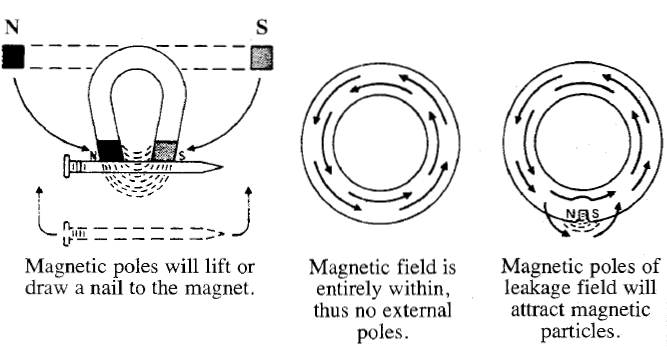CHARACTERISTICS OF MAGNETIC FIELDS
The magnetic field surrounding a permanent bar magnet has
polarity. As an example, the Earth itself can be considered a bar magnet because of its two poles. Quite frequently, the magnetic field surrounding the Earth strongly magnetizes large ferromagnetic objects that lie aligned with the Earth’s poles for periods of time.
Magnetic poles in a straight bar, horseshoe and broken magnet are shown in Figure.
The bar magnet is useful for visualizing the concept of lines of force describing a magnetic field. As illustrated in Figure, a bar magnet is covered with a sheet of paper, and iron filings are scattered over the paper. The iron filings arrange themselves in characteristic patterns called lines of force. These lines of force, called magnetic flux, never cross. They seek the path of least magnetic resistance, they are most densely packed at the poles of the magnet, they flow from north to south poles outside the magnet, but from south to north poles within the magnet and they do not enter or
leave at the center of the magnetic field.
If a bar magnet is bent, fusing the north and south poles, the
magnetic field would not escape the now circular form of the
magnet. The magnetic domains form a closed magnetic loop or circuit, and the test object appears to be unmagnetized. The test object may support magnetization in directions other than circumferentially around the ring. The ring magnet may have a long direction perpendicular to the direction of the enclosed circular magnetic field and may be called a tube. This type of circular field can be set up in platings or coatings of ferromagnetic materials around a hollow or solid shaft of a nonmagnetic material.
The shape of the magnet does not necessarily dictate where the poles are located. This is determined by a combination of the shape and the direction of the applied field.
